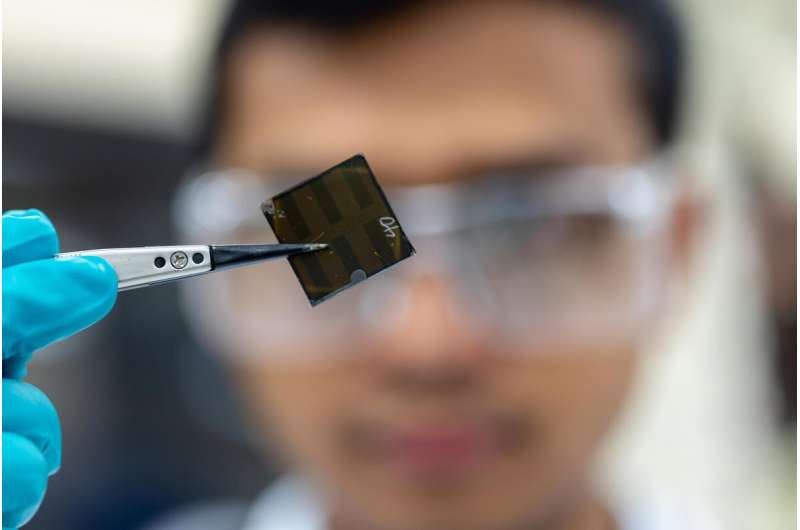Perovskite solar cells designed to take the heat in high-humidity environments

As global sustainability and clean energy megatrends impact how we approach energy strategies toward a greener future for the planet, renewable technologies such as wind and solar are leading areas of focus for research. In the solar technology space, the emerging field of perovskite solar cells (PSCs) has gained popularity within the last decade and a half for offering high power conversation efficiencies (PCEs).
However, in a field dominated by silicon solar cells, the relatively new technology must also meet two other crucial requirements to be successfully commercialized: stability and scalability.
In a recently published Science paper, "Damp heat–stable perovskite solar cells with tailored-dimensionality 2D/3D heterojunctions," KAUST researchers reported a significant milestone through the first-ever successful photovoltaic (PV) damp-heat test of PSCs.
The damp-heat test is an accelerated and rigorous environmental aging test aimed at determining the ability of solar panels to withstand prolonged exposure to high humidity penetration and elevated temperatures. The test is run for 1,000 hours under a controlled environment of 85% humidity and 85 degrees Celsius. It is meant to replicate multiple years of outdoor exposure and evaluate factors such as corrosion and delamination.
Passing the test
The harshness of the test is in line with commercialization requirements that states PV technology must cover 25 to 30 years of warranty for conventional crystalline-silicon modules. In order to pass the test, the solar cell has to maintain 95% of its initial performance.
Led by first author Randi Azmi, a postdoctoral fellow in professor Stefaan De Wolf's KAUST Photovoltaics Laboratory, their research had to overcome an enduring weakness in encapsulated PSCs to prevent packaging leakage.
Applied through a thin-film coating process, perovskites are sensitive and highly affected by the presence of humidity. This vulnerability of the 3D perovskite films allows an unwanted infiltration of atmospheric agents, such as moisture, with limited resilience against heat. Stability is essential to their functioning.
KAUST researchers found that engineering and introducing 2D-perovskite passivation layers blocked the moisture and simultaneously enhanced the power conversion efficiencies and lifetime PSCs.
Can perovskites replace silicon?
The specificity of perovskites is that it's a thin-film technology. As is the case with conventional solar cells, two contacts made of specific types of materials are still required. One collects electrons, and the other collects positively charged 'holes,' which represent the absence of electrons. Unlike silicon wafers, perovskite ink can be coated directly on a glass substrate, coupled with antisolvent extraction, followed by thermal annealing to fully crystallize the perovskite film. The perovskite ink is essentially formulated from a mixture of salts in a polar aprotic solvent at a low-temperature (typically lower than 100 Celcius).
One of the significant advantages is that precursor materials can be made without the need for expensive facilities and energy-intensive environments exceeding 1,000 degrees, which is typical for more traditional semiconductors such as silicon.
"It's a very simple way to make solar cells," said De Wolf. "While the optoelectronic properties are not unique, they are excellent. They're on-par with very high-quality traditional semiconductors. That's quite remarkable."
By altering the composition, he said it's also possible to tune the spectral sensitivity across the solar light spectrum from UV up to infrared. "This is quite attractive for certain applications."
The remaining challenge, after performance and stability, is scaling. Most solar cell applications are focused on utility-scale sectors and rooftop panels. While the latter is not prominent in Saudi Arabia, utility projects being pursued in the Kingdom include large PV fields in the desert.
"The market is silicon-based, and it will be silicon-based for the next 20 years at least," said De Wolf. The KAUST Photovoltaics Lab is mainly focused on improving the performance of perovskites solar cells in order to advance more efficient "tandem" solutions, pairing both traditional silicon and perovskites.
To this end, he said the current findings will aid much in increasing the reliability of perovskite-silicon tandem solar cells.
More information: Randi Azmi et al, Damp-heat stable perovskite solar cells via 2D/3D heterojunctions with tailored dimensionality, Science (2022). DOI: 10.1126/science.abm5784. www.science.org/doi/10.1126/science.abm5784


















